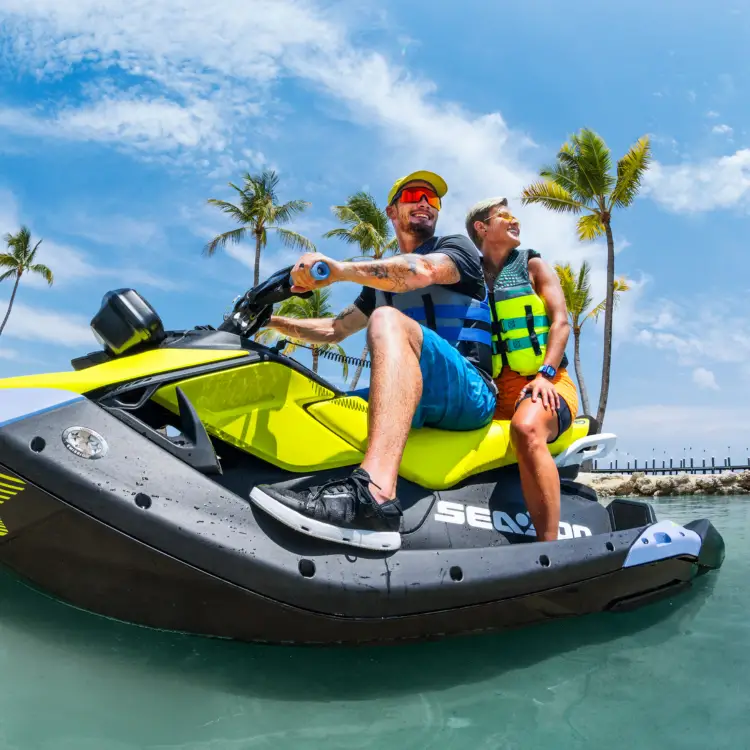Sloop Boats
Sloop: Understanding the Classic Sailboat Design and Its History
A sloop is a type of sailboat characterized by its single mast and fore-and-aft rigging. With a diverse range of designs and configurations, sloops have a storied history in nautical culture. They have evolved over time to include modern variations, which continue to be popular among sailors today.
Traditionally, sloops were rigged with one or more headsails and a mainsail, which could be triangular in shape or gaff-rigged. In their early days, the definition of a sloop was quite vague, with sailors customizing their rigs based on personal preferences. However, over time, the characteristics of sloops have become more defined, and today, they are among the most recognizable and widely used sailboats in both recreational and competitive sailing.
Key Takeaways
- Sloops are sailboats with a single mast and fore-and-aft rigging
- They have a diverse and storied history in nautical culture
- Modern sloops remain popular, offering versatility for sailors
Historical Background
The sloop, a single-masted sailing vessel, has a history dating back to the early 17th century. With its fore-and-aft rigging, mainsail, jib, and sometimes one or more headsails, it offered the advantages of easy handling and the ability to sail upwind. The sloop became particularly popular in the 20th century for its versatility and performance. One notable early example is the Bermuda sloop, which played a crucial role in trade between Bermuda and North America.
One historically significant variant of the sloop is the sloop-of-war, a small warship that typically mounted about 20 guns. These vessels were employed by various countries, including the United States, France, and the United Kingdom, throughout the 18th and 19th centuries. Sloops-of-war were valued for their maneuverability and speed, making them ideal for patrolling and escorting duties during times of conflict.
In the Atlantic region, sloops played an essential role in coastal trade and transportation. The Hudson River sloop, for example, was the primary means of transportation on the Hudson River from the 1600s until the arrival of affordable steamboats in the 1820s. It efficiently transported goods and people between the bustling ports of New York and Albany.
Sloops were also quite common in the state of Maine and other areas of the eastern United States. They served as versatile workhorses, carrying cargo, passengers, and providing a variety of services like fishing, coasting, and even piracy. As a result, sloops became synonymous with the economic growth and development of the region.
In conclusion, the history of the sloop showcases its importance as both a versatile sailing vessel and an essential means of transportation and commerce throughout the Atlantic region, including the United States and France. Its adaptability and performance have ensured its continued use and relevance through the centuries.
Design and Features
The sloop is a popular sailboat design known for its simplicity and versatility. In this section, we will explore the main features of a sloop, including its mast and sails, and the different rig types commonly used.
Mast and Sails
A sloop is a single-masted sailboat with a fore-and-aft rig configuration. This means that the sails are placed along the centerline of the boat, perpendicular to the mast. The sloop typically features two sails: the mainsail and the jib or headsail. The mainsail is the larger sail mounted aft of the mast, while the jib is the smaller sail situated forward of the mast. The combination of these two sails allows for efficient upwind sailing, making the sloop a versatile choice for various sailing conditions.
Bermuda Rig
The Bermuda rig is the most common type of rig used on sloops today. It is characterized by a triangular mainsail with its leading edge attached to the mast and its trailing edge, or "leech," held taut by a boom at the base of the sail. The jib, also triangular, is attached forward of the mast between the bow and the masthead. The Bermuda rig is popular for its ability to sail efficiently into the wind, its simplicity, and ease of handling, making it well-suited for a wide range of sailing activities.
Gaff Rig
Another sloop rig variation is the gaff rig, which features a four-sided mainsail supported by a spar, known as the gaff, near its upper edge. This rig allows for a larger sail area than the Bermuda rig, which can provide more power in light wind conditions. However, the gaff rig is less efficient when sailing upwind due to increased wind resistance, making it less common in modern sloop designs. While not as prevalent as the Bermuda rig, the gaff rig is still appreciated by some sailors for its traditional aesthetics and suitability for certain types of sailing experiences.
In summary, the sloop is a single-masted sailboat with a distinct design that incorporates a mainsail, a jib or headsail, and either a Bermuda or gaff rig, depending on the specific model. Its design provides an efficient, versatile, and straightforward sailing experience, making it a popular choice for many sailors around the world.
Utility and Control
Sloops are known for their versatility and ease of handling in various conditions. Their single mast and fore-and-aft rig set-up allows sailors to control the direction of the boat with greater precision. This makes sloops a popular choice among sailors for both leisure and professional purposes.
In terms of water navigation, sloops offer greater control and flexibility in their deployments. They can be used for a range of activities, such as racing, cruising, and even exploring shallow waters due to their smaller draft. The simple rig configuration also makes it easier for sailors to adjust and maneuver the sails, enabling quick responses to shifts in wind conditions or changes in course.
Control is essential when managing the various sail adjustments on a sloop. Oftentimes, sailors need to account for environmental factors such as water currents and gravitational forces. By adjusting the tension on the lines, mast position, and sail shape, sailors can effectively counteract gravity and maintain optimal control over the sloop.
In certain deployments, sloops can benefit from the added control and utility provided by advanced control loop technologies in their systems. Such technology can monitor the vessel's position in the water, identify imbalances caused by gravitational forces, and automatically adjust the sail settings to maintain balance and optimal sailing performance.
In conclusion, sloops provide a high level of utility and control for sailors across various conditions and deployments. The ability to easily adjust sails, account for gravity, and even implement advanced control loop systems makes sloops a popular and versatile option for sailing enthusiasts. With clear, concise design and sailing advantages, sloops continue to be a go-to choice for many sailors worldwide.
Sloops in Popular Culture
Sloops have also found their way into popular culture, including online games and entertainment. One example of this is the Slope game, which, although not directly related to sailboats, shares a similar name and may be inspired by the sailing world. The Slope game is a fast-paced 3D endless running game developed by Rob Kay. It challenges players to achieve a high score by navigating a constantly changing and challenging terrain.
The gameplay is intuitive and easy to learn, using just the arrow keys to control the ball's movement, making it suitable for players of all ages. Slope game can be played in full-screen mode, providing a more immersive experience and enhancing the enjoyment for players. Its simplicity and addictive nature have made it popular among casual gamers who appreciate the straightforward controls and the satisfaction of achieving higher scores.
In summary, while sloops may be best known for their sailing capabilities and historical significance, their influence extends beyond these realms. The prevalence of sloops or their nomenclature in popular culture, such as in the Slope game, demonstrates the lasting impact these sailboats have had on various aspects of entertainment.
Modern Sloops
Modern sloops have come a long way since their origins in the 17th century. They maintain their distinct fore-and-aft rig with a single mast, which is typically rigged with triangular sails, often referred to as a Bermuda rig. This configuration allows for excellent upwind performance and ease of handling, making sloops one of the most popular sailing craft in the world today.
Advancements in technology and materials have greatly improved the performance and comfort of modern sloops. Carbon fiber masts, advanced sail materials, and efficient hull designs have made these vessels lighter, faster, and more responsive. In addition to these improvements, the incorporation of modern navigation, communication, and safety systems ensures that sailors can focus more on enjoying their time on the water and less on managing complex systems.
Electric propulsion is another innovation that is gaining traction in the sailing community. Some modern sloops are designed with electric motors, eliminating the need for noisy and polluting diesel engines. These electric motors can be powered by solar panels or regenerative systems that recharge the batteries while sailing. This eco-friendly solution not only makes for a quieter and cleaner sailing experience but also reduces the overall environmental impact of the vessel.
Although sloops remain a popular choice for sailing enthusiasts, it is important to note that they are not the only option available. There are many other types of sailing craft, each with its strengths and weaknesses. Sloops, however, continue to stand out as a versatile and efficient choice for sailors of all skill levels.
In summary, modern sloops have evolved significantly from their humble beginnings, incorporating cutting-edge technology, materials, and design principles to create highly efficient and enjoyable sailing craft. With their timeless allure, versatility, and eco-friendly electric options, it is no surprise that sloops continue to be a top choice for sailors around the world.
Challenges and Solutions
Sloop is a powerful tool designed to store and visualize Kubernetes events. However, like any tool, it faces its own set of challenges. In this section, we will discuss some of these challenges and the solutions to overcome them.
Among the challenges faced by Sloop is the unpredictable nature of storms in the Kubernetes ecosystem. Storms can make it difficult to manage and monitor system performance, especially when it comes to keeping track of events. Fortunately, Sloop is specifically designed to handle such unpredictable situations. With its ability to store and display information on various Kubernetes events, Sloop helps administrators navigate through the turbulence caused by storms.
Gravity can also pose obstacles for Sloop users, as it can affect the tool's performance. Data storage and retrieval might become slower due to gravity's impact on the underlying resources. To overcome this challenge, Sloop leverages efficient algorithms and data processing techniques to minimize the effects of gravity on its performance. This ensures that users can access the necessary information quickly and reliably.
Inevitably, there will be times when Sloop users must face unexpected obstacles. Whether it's due to external factors like system upgrades or internal factors like code modifications, these obstacles can hinder the effectiveness of Sloop. To mitigate these challenges, users should remain up-to-date with the latest Sloop documentation, best practices, and system requirements. Staying informed will enable users to tackle these issues and maintain a well-functioning system.
Lastly, the process of managing Kubernetes events can be destroyed by a lack of proper planning and communication. This is especially true when dealing with complex systems that involve multiple teams and stakeholders. In response to this challenge, it is crucial for users to ensure clear and open communication channels. This may involve utilizing advanced communication tools such as supplier portals, cloud-based collaboration platforms, and real-time data sharing.
Being confident, knowledgeable, and clear when using Sloop and addressing challenges will ultimately lead to a better management of Kubernetes events. By addressing these challenges head-on and incorporating necessary solutions, users can harness the full potential of Sloop in managing and monitoring their Kubernetes ecosystems.
Glossary
A sloop is a type of sailing vessel characterized by its single mast and two sails, typically a mainsail and a headsail. The simplicity of this rigging makes it a popular choice for both recreational and racing sailors. We will now explore some important terms related to sloops – their design and operation – with a confident, knowledgeable, neutral, and clear tone.
Stern: The stern is the rear or aft part of a sloop or any other boat. It plays a crucial role in the overall stability and maneuverability of the vessel. On a sloop, the lines running from the mast to the stern help control the mainsail.
Draft: The draft of a sloop refers to the vertical distance between the waterline and the lowest part of the boat, usually the keel. Draft determines the minimum water depth necessary for a sloop to operate without running aground. A shallow draft enables a sloop to sail in shallower waters, whereas a deeper draft improves stability and windward performance.
Range: In nautical terms, the range refers to the distance a sloop or any other vessel can travel without refueling or resupplying. As sloops typically rely on wind power for propulsion, their range is primarily limited by factors such as crew endurance, provisions, and the availability of suitable wind conditions.
In addition to these terms, it is essential to understand some basic sloop components and their functions:
- Mast: The mast is the vertical support structure for the sails on a sloop. On a sloop, there is only one mast, set about one-third of the boat's length aft of the bow.
- Mainsail: The mainsail is the primary and largest sail on a sloop. It is attached to the mast and the boom, a horizontal spar extending from the mast.
- Headsail: The headsail, also known as the jib or genoa, is the second sail on a sloop, hoisted to the top of the mast on the forestay. It contributes to the boat's forward propulsion and helps with maneuvering.
A dictionary definition of a sloop would be: "a fore-and-aft rigged boat with one mast and a single jib." This concise definition captures the essential characteristics of a sloop, making it a valuable starting point for delving deeper into the world of sailing and nautical terminology.
Frequently Asked Questions
What is the main difference between a sloop and a ketch?
The main difference between a sloop and a ketch lies in the sail configuration. A sloop features a single mast with a mainsail and a headsail (typically a jib), while a ketch has two masts: a taller main mast and a shorter mizzen mast situated aft of the main mast. The ketch has additional sails, including the mizzen sail, which provides more sail area and better sail balance.
How does a sloop differ from a schooner?
Sloops and schooners both have distinct sail configurations. A sloop is characterized by a single mast with a mainsail and a headsail, whereas a schooner has two or more masts, with the aft mast (the one furthest back) being taller or of similar height to the forward mast. Schooners generally have more sail area than sloops, making them more suited for long-distance sailing and cargo transport.
What are the advantages of a sloop over a cutter?
The main advantage of a sloop over a cutter is its simplicity and ease of handling. Sloops have a single headsail, whereas cutters feature two or more headsails. This simplicity makes sloops easier to sail, especially for single-handed sailors or small crews. Additionally, sloops typically have more effective upwind performance than cutters due to their cleaner airflow around the sails.
Are sloops suitable for long-term living aboard?
Sloops can be suitable for long-term living aboard, depending on the size and layout of the boat. Many modern sloops are designed with comfortable accommodations, including cabins, galley, and head facilities, making them ideal for extended cruising or liveaboard situations. However, individual preferences and needs may vary, so it's essential to evaluate each boat on a case-by-case basis.
What is the expected size range for a sloop?
Sloops come in various sizes, from small daysailers to larger yachts. Typically, sloop length can range from 20 to 60 feet or more. Smaller sloops are popular choices for daysailing and weekend cruising, while larger sloops offer more space and amenities for long-term voyages or living aboard.
How does a sloop perform in Sea of Thieves?
In the popular video game Sea of Thieves, the sloop is the smallest and most maneuverable ship, ideal for one to two players. It features a single mast with two sails: a main and a smaller headsail. Due to its size and maneuverability, the sloop is an excellent choice for quick getaways and tight spaces, giving players an advantage when evading larger ships or navigating through treacherous waters.
Specifications
Featured Brands
All Brands for Sloop Boats
- Alberg
- Aloha
- Alubat
- Amel
- Antaris
- Azimut
- Baltic
- Bavaria
- Beneteau
- Black Workboats
- Bobsloepen
- Breedendam
- Bristol
- C C
- CAL
- CNB
- CS
- Cape Dory
- Catalina
- Cheoy Lee
- Classic
- Clever
- Comar
- Compromis
- Contessa
- Corsiva
- Custom
- Damarin
- Dehler
- Dufour
- Elan
- Endeavour
- Enkhuizensloep
- Ericson
- Etap
- Formula
- Freedom
- Gib'Sea
- Grand Soleil
- Gulfstar
- Hallberg
- Hallberg-Rassy
- Hans Christian
- Hanse
- Hinckley
- Hoek
- Hunter
- Hylas
- Interboat
- Irwin
- Island Packet
- Islander
- Jan Van Gent
- Jeanneau
- Jongert
- Kirie
- Lago Amore
- Langweerder Sloep
- Lifestyle
- Luxury
- MacGregor
- Makma
- Malo
- Maril
- Maritimo
- Marlow
- Maxima
- Mirage
- Moody
- Morgan
- Najad
- Nautor Swan
- Newport
- O'Day
- Oud Huijzer
- Oyster
- Passport
- Pearson
- Perini Navi
- Pogo
- Primeur
- Qrafter
- Reddingssloep
- S2
- Sabre
- Sadler
- Silver Yachts
- Sloep
- Sloop
- Solaris































